MEZIN (АРТЭФАКТЫ)
(частка 3)
This view of the painted jaws shows what may be damage from drum sticks on the inside of the left jaw.
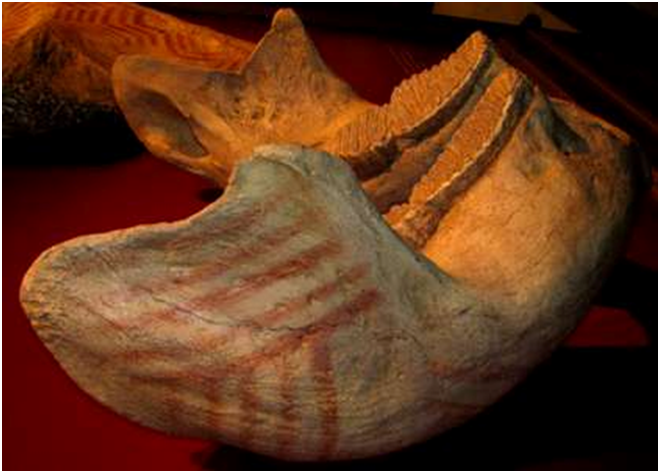
Photo: Don Hitchcock 2008 Source: Facsimiles, Vienna Natural History Museum

The original jam session. Assistants at the Ukrainian Museum of Archaeology, Kiev, are here seen in 1976 recreating the sounds of an Upper Paleolithic "orchestra" using painted mammoth bones found at the site of Mezin.

The bones date from about 20 000 BC The instruments consist of
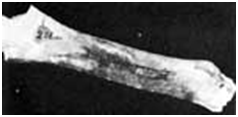
a mammoth shoulder blade as a drum with an antler hammer, a mammoth hip bone said to resonate with different tones like a xylophone,

parts of a "castanet"
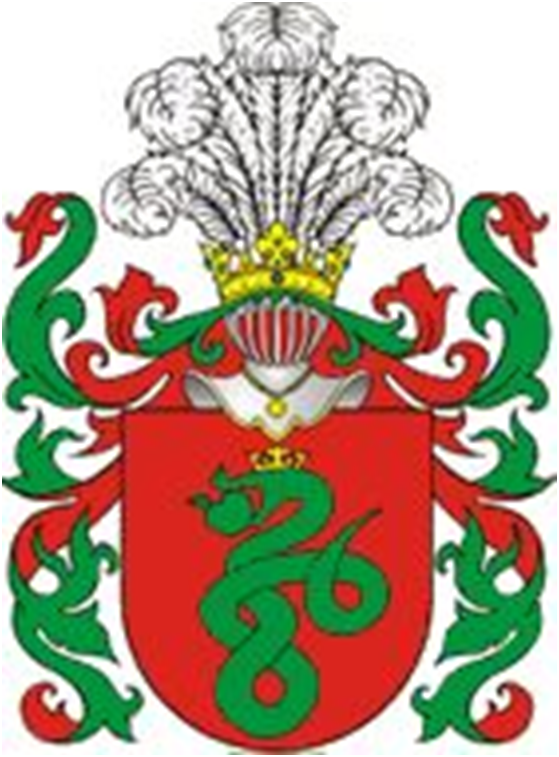
and a "rattler" made from mammoth jaws.
Photos: Secrets of the Ice Age by Evan Hadingham, 1980
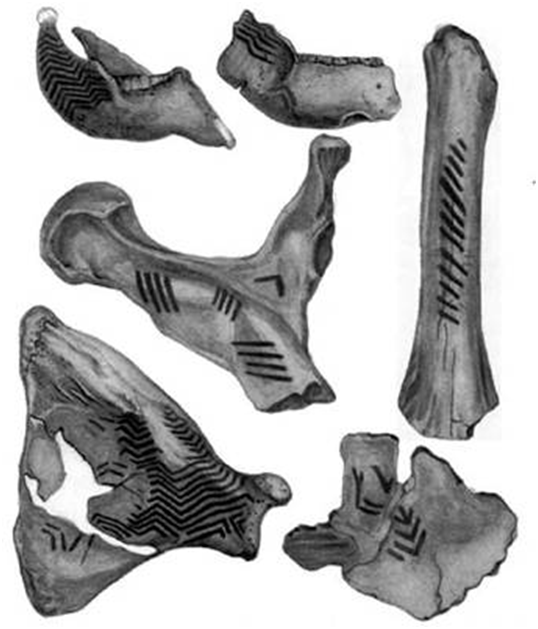
Mammoth bones decorated with geometric designs from Mezin on the Desna River (after Pidoplichko 1969, 97, fig 31) The site of Mezin is located on the Desna River approximately 25 kilometres downstream from the city of Novgorod-Severskii in the Ukraine. The occupation area lies on the lower slope of a large tributary ravine near its confluence with the main valley, approximately 10 metres above the modern river bed. The artifacts and features are buried in loess-derived colluvium, and their stratigraphic and chronologic position is not well defined. Three radiocarbon dates obtained on mammoth teeth yielded ages of 29 000, 21 600, and 15 100 years BP. Mezin was discovered in 1908 by F. K. Volkov, and was excavated over the course of many decades by Ukranian and Russian archeologists such as Efimenko, Voevodskii, and Shovkoplyas. Over 1200 square metres of the occupation area was eventually exposed. The features appear to include at least two former structures of mammoth bone, several bone filled pits, hearths, and debris concentrations. More than 113 000 stone artifacts were recovered, with burins predominating heavily among the tools, and the nonstone inventory uncluded a large and diverse inventory of tools and art. THe associated faunal remains are primarily mammoth and arctic fox, but large numbers of wolf, horse, reindeer, and musk-ox are also present
Photo and text: Hoffecker (2002)

Omoplate de mammouth peinte utilisée dans la construction d'une des cabanes de Mézine.
Photo L. Iakovleva. Painted mammoth scapula used in the construction of one of the huts of Mezin.
This appears to be very similar to the scapula depicted above, rotated through 180°.
Photo L Iakovleva. Photo and French text: "les mammouths - Dossiers Archéologie - n° 291 - Mars 2004" My thanks to Anya for access to this resource.

Aiguille à chas gravée de chevrons en ivoire de mammouth de Mézine - Collection MNIU. Mammoth ivory needle with eye, engraved with chevrons, from Mezin. Collection MNIU.
Photo and French text: "les mammouths - Dossiers Archéologie - n° 291 - Mars 2004" Photograph L Iakovleva. My thanks to Anya for access to this resource.

Statuette féminine sculptée avec double triangle pubien et chevrons gravés de Mezine - Collection MNIU - Photo L. Iakovleva. Female statuette carved with double pubic triangle and engraved chevrons, from Mezin - Collection MNIU - Photograph L Iakovleva. Photo and French text: "les mammouths - Dossiers Archéologie - n° 291 - Mars 2004" Photograph L Iakovleva. My thanks to Anya for access to this resource.
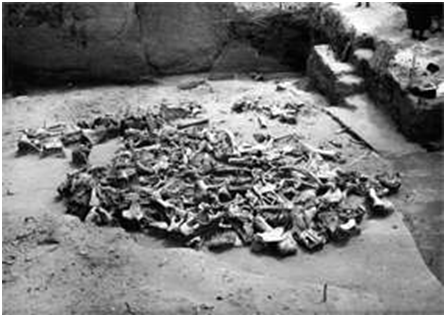
Cabane No 1 de Mézine avec les zones d'activité de plein air. Photo IA NASU Photo and text: Archeometriai Müely 2005/4 Les parures en coquillages au Paleolithique superieur recent dans les territoires de peuplement du bassin du dniepr by Lioudmila Iakovleva From: http://www3.calle.com/info.cgi?lat=51.8167&long=33.0833&name=Mezin&cty=Ukraine&alt=403 Latitude 51.8167 Longitude 33.0833 Altitude (feet) 403 Lat (DMS) 51° 49' 0' N Long (DMS) 33° 4' 60' E Altitude (metres) 122 From: http://history.cn.ua:8101/english/ The Chernigov Regional Historical Museum by V. Tarnovsky is the oldest and best known in Ukraine. It was founded in 1896. The settlement of Mezin is one of the oldest in Ukraine and belongs to the Paleolithic. Excavation showed that it consisted of five household complexes. The time of the settlement existence may account for 22-23 years. At least seven families totalling 50 people lived there. They hunted for large animals and in most cases for mammoths. Collective hunting gave them food, skins for covering dwelling houses and clothes. Bones of large animals were the best building materials at that time. On display in the museum are bones of mammoth's shoulder, lower jaw, and tusk. Flint tools are widely represented by various cutters, scapers, and prickers. The Mezin settlement have become famous of their works of art. The inhabitants made ornaments from mammoth's bone, and liked decorative items made from cockleshell. The settlement of Mezin is celebrated for its oldest musical instruments complex, which consists of an ornamented mammoth shoulder, antler hammer, noisy bracelet. The inhabitants performed their dances under this music more than 20 000 years ago. This reconstruction is of the remains of a similar hut to those of Mezin, but found in Germany: Gönnersdorf (Rhénanie-Palatinat), Magdalénien supérieur, vers 12 600. Cette reconstitution réaliste de l'habitation no 1 (Ø = 7 m) s'inspire librement d'une yaranga tchouktche; la carcasse en bois dont le toit s'appuie sur un mât central est recouverte de peaux de chevaux, l'entrée cloisonnée largement ouverte au sud-est laisse voir le dallage de schiste et le support d'une broche à un fémur de mammouth.
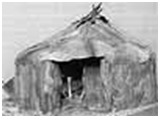
Gönnersdorf (the Rhineland-Palatinat), higher Magdalenien, around 12 600 BP. This realistic reconstruction of the dwelling No 1 (diameter = 7 m) is similar to a yaranga (the traditional circular dwelling tent) of the Tchouktche people of Siberia. The structure's roof is supported on a central pole and is covered with horse hides, the partitioned entry opened to the south-east lets us see the schist (flag stones) pavement and the femur of a mammoth. From: http://fulbright.kiev.ua/cohen/index.htm The palynological spectra of Mezirich site (Middle Dnieper area), that is about the same latitude as a Rogalik-Peredelsk group, marks undoubtedly prevailed steppe periglacial landscape. The pollens of a birch, alder and pine are rather individual (Dolukhanov, Pashkevich, 1977; Kornietz and all., 1987, p. 109).



